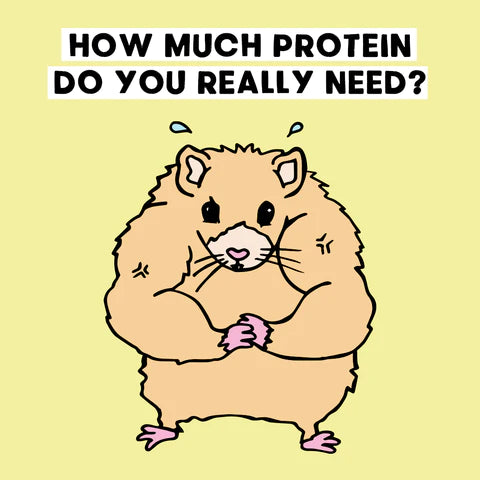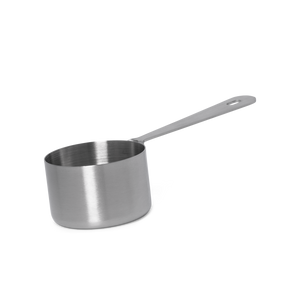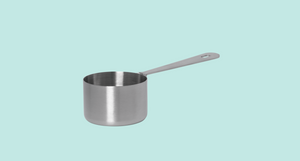Have you ever felt like you could commit a crime just to get a bite of that food you’re so desperately craving? You are not alone. We’re right there with you, and so is more than 90 percent of the population (1). (Don’t do it though.)
What are food cravings?
Food craving can be defined as an intense desire to eat a specific food and it comprises out of two elements. Firstly, ‘the desire’ refers to an intense appetitive motivation to eat - so strong that we might go out of our way to do so. The second critical aspect is ‘the specificity’. It refers to the idea that we desire a certain type of food, due to the sensory pleasure derived from eating that given food.

The specificity element is also crucial in distinguishing food craving from hunger. When we are hungry, any of a wide variety of foods could be satisfying. However, when speaking about food craving, there is a sensory memory that must be matched in order to satisfy that craving (2). We can experience food craving even when we are completely full. But if you are curious to find out more about the science behind feeling full or hungry, we suggest you to read this article.
Now, imagine this, you just finished a starter and a main at your favourite restaurant and you are more or less in a “food coma” by now. Yet, they have that crazy cheesecake on the menu. You know the one with raspberries and an extra layer of chocolate on top. What are the chances you will say no to it? The dopamine “wanting” system in our brain is powerful. It’s capable of influencing us to continue to eat, even if the pleasure of eating has subsided. This is simply because us humans are hardwired with an insatiable feeling of longing. If we switch to a different food - that cheesecake, for example - pleasure can be prolonged until we’re utterly stuffed. And hereafter often follows regret and guilt.(3).
Why we experience food cravings?
Research identifies two main reasons for why we experience food cravings. The first stream of research highlights that food cravings arise in response to a nutrient or caloric deficit. For example, if you are craving salty snacks, nutritional research suggests that you are deprived of chloride or silicon, and can reduce the craving by eating fish or nuts. Or if you are craving sweet foods, you are lacking chromium, carbon, sulphur, or phosphorus, and can satisfy it by eating foods like broccoli, grapes, spinach, and sweet potatoes.
Correct us if we’re wrong, but broccoli isn’t quite the same as a sea-salt caramel milk chocolate bar, right? That is why the second stream of research argues that craving is actually caused by our mind and not by nutritional deficiencies. Experiencing an uncontrolled desire to consume chocolate cannot really be explained by nutritional deficit, as chocolate doesn’t really contain high levels of any nutrients that we could be so extremely deficient in.
Hence, the most common belief is that cravings arise due to the fact that if we don’t get something we want, we will “desire” it even more. It’s a vicious cycle. Let’s take chocolate, for example. It’s perceived as the most commonly palatable sweet treat and as highly emotionally soothing. Sad? Eat a piece of chocolate. Stressed? Here is some chocolate. No doubt, chocolate makes the world a better place. But we also all know that it should be eaten in moderation as it is high in sugar and fat. The attempt to restrict its intake, however, can activate our brain to react in an impulsive and uncontrollable way, leading to desire for eating it even more (3).
Another way we can explain food cravings is by looking at it though the behavioural psychology lens. Ever wondered why every time you “crave” popcorn, it just happens to be that you are standing in the cinema. In the early 1900s, the Nobel prize winner Ivan Pavlov proposed the idea of classical conditioning. It refers to the idea that the behaviours are a consequence of preceding external stimuli. Our nervous system creates “reflexes”, which are not in a conscious control of the individuals, to respond to a certain stimuli.
In classical conditioning terms, it goes as follows. Before conditioning, the unconditioned stimuli of smelling that fresh popcorn leads to an unconditioned response of popcorn craving. During the conditioning, we are pairing the conditional and unconditional stimuli, which is entering the cinema and smelling the popcorn. After the conditioning, the conditioned stimulus becomes the cinema. Therefore, even if we were to enter the cinema and there was no sign or smell of popcorn present, we would most likely experience the feeling of craving to eat popcorn.
We believe both reasonings are valid. It’s important to create balance in your daily diet, and consume sufficient levels of all the required nutrients. We actually know of pretty neat products that can help you with that, these meals contain all the nutrients your body needs to work at its optimal level and reduce those food cravings. But we also believe that it’s important to be aware of your internal satiety signals. One recent practice developed to deal with food cravings is known as “mindful eating”.
Fight food cravings with mindful eating
Mindful eating is not a diet; it is the practice of being aware and present while you are eating. You won’t need to count any calories or restrict any foods. It simply means that you will pay attention to what you are eating and how you feel when eating it. You will tune into your body’s physical and psychological cues before and after eating the meal. Cravings are one of the many ways your body communicates to you. So, using mindful eating, you can uncover why you’re experiencing cravings and how you can adjust to give your body what it needs (4).
Practicing mindful eating can benefit you in many ways. For example, it can make your inner body clock aware of when the optimal time to start or stop eating is. Moreover, it can bring about a better management of your emotions. It's commonly known that some people respond by overeating or restricting to eat to deal with negative emotions. And finally, mindfulness can help you take full control over your food cravings (5).
An experiment was created among the Dutch population, investigating the effectiveness of coping with and reducing the food cravings by means of mindfulness methods (6). The results showed that participants in the experimental group which practiced mindfulness experienced significantly lower food cravings. In particular, mindfulness reduced the feeling of losing control when exposed to sensory food cues.
Another applicable finding is also that us humans largely develop our taste buds in the first 24 months of our life. First we are exposed to milk via sense and taste and we also develop an attraction to foods that our mother ate when we were still in her belly (7). But interestingly enough, research shows that taste buds can change. What you found tasty years ago, may not seem that appealing today. Food trends and environments also shape our minds and desires. Recent food movement has been putting a large emphasis on the adoption of plant-based diets. If you are one of those people who have been trying to consume less meat, maybe due to health or environmental reasons, then you might have noticed how your taste changed over time. Taste buds normally require about one month to adapt to a new liking. If one month ago you thought a medium rare steak was what got you drooling, today you might flinch at a thought of eating meat.
Eating mindful is important to keep a healthy and nutritious balance, and to break that vicious cycle of food craving. So, let’s cut to the case: how can you practice mindful eating? There is no one approach to eating mindfully, because it is not a strict practice, it is simply a development of a new habit. Did you know that it normally takes 21 days of consciously engaging with the goal we set for ourselves to become our new habit? What do you say we first do a little trial and start with 7 days of mindful eating. The enjoyment and feeling good are the main goals. So, if after 7 days you are not convinced, you can always say “well, at least I’ve tried”.
Step-by-step guide to mindful eating
Here we go! There are 7 steps to mindful eating. We visualised them for your convenience below. The steps work continuously, reinforcing one another, and mindfulness means paying attention in a particular way: on purpose, in the present moment, and without judgement.
Step 1 - Listen to your body: are you hungry or thirsty? Have you drank enough water today? When you don't drink enough water, your body receives mixed signals of hunger. Dehydration causes you to believe you need to eat when you actually need liquid intake.

Step 2 - Be aware: eat when your body tells you to eat. For example, when you hear your stomach growling or you feel low on energy. But avoid eating out of snacking habits or out of boredom. You can’t control everything in your life, but you sure can control what food your body consumes.

Step 3 - Be present: before eating pause for a second. Look around where you are. Are you sitting comfortably? Do you feel safe? Is there fresh air in the room? Try to let go of the thoughts about anything else, rather than enjoying the meal that is in front of you. Avoid distractions. Take a break from looking at the screen and just appreciate the food you are about to eat. Consider where your food comes from.

Step 4 - Slow down: don’t rush eating. Taking time to chew slowly results in having better digestion and feel fuller, faster and longer. And stop eating when you feel full. You can always store and save what you can’t finish for the next day. Don’t just eat to finish the entire plate.

Step 5 - Engage your senses: try closing your eyes at the first bite of your meal. Think of what aromas, taste, textures you are experiencing? Notice the sound and the smell of your food. Think of why this combination of foods fits together. Why do you enjoy it? How does it make you feel?

Step 6 - Focus on nutrition: incorporate foods in your diet that are nutritionally healthy and beneficial for your body. You can read everything you need to know about nutrition in the following article: macronutrients and micronutrients. How about replacing rice crackers and hummus for lunch with Jimmy Joy products, which provide you with the most convenient way to enjoy a delicious and nutritionally complete meal?

Step 7 - Be kind and non-judgemental: this is your body and the food is the fuel that keeps it going. Accept your body and its needs. If you don’t have the time or energy to approach a meal mindfully, that’s alright. There will be many more meals where you can practice being mindful. Don’t be too hard on yourself. Sometimes you just have to go for what crave! And don't judge yourself. We sure won’t. Cheesecake, anyone?

After practicing mindful eating we would like you to reflect on your experience. Perhaps you will gain a different outlook on your relationship with food. If you are interested in how you can combine mindfulness with weight management, we suggest you read these articles next: fat loss, weight gain, weight maintenance. And don’t hesitate to let us know about your experience with mindful eating and how Jimmy Joy products help you with it here.
Sources
(1) Weingarten, H. P., & Elston, D. (1991). Food cravings in a college population. Appetite, 17(3), 167-175.
(2) Pelchat, M. L., Johnson, A., Chan, R., Valdez, J., & Ragland, J. D. (2004). Images of desire: food-craving activation during fMRI. Neuroimage, 23(4), 1486-1493.
(3) Baerten, C. (2016). Understanding Our Cravings to Eat. Educational Handout.
(4) Kooienga, M. (2019). Reasons Why You’re Experiencing Food Cravings. Retrieved from https://nutritionstripped.com/causes-of-food-cravings/
(5) Germino, D. (2018). This Practice Will Make You Stop Your Food Cravings. Retrieved from https://medium.com/@dgermino/this-practice-will-make-you-stop-your-food-cravings-253dd1bbceae
(6) Hugo, J.E.M., et al. (2010). Coping with food cravings. Investigating the potential of a mindfulness-based intervention. Appetite, 55:1, 160-163.
(7) Schaal B, Marlier L, Soussignan R. Human foetuses learn odours from their pregnant mother's diet. Chem Senses. 2000;25(6):729-737. doi:10.1093/chemse/25.6.729

 Everything You Need In One Meal
Everything You Need In One Meal
 Stay Full For 3-5 Hours
Stay Full For 3-5 Hours




















 Product added to cart
Product added to cart





















